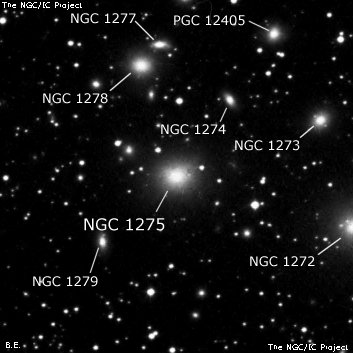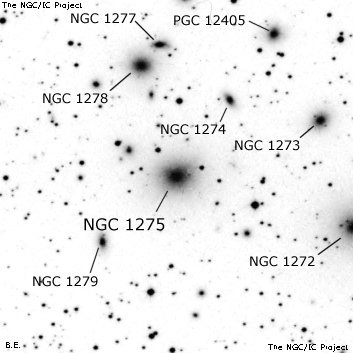NGC/IC Project Restoration Effort
(This is a very very beta version)
NGC1275


Basic Information
Location and Magnitude
Right Ascension: 3:19:48.1
Declination: +41:30:41
Constellation: PER
Visual Magnitude: 11.9
Historic Information
Discoverer: Herschel W.
Year of discovery: 1786
Discovery aperture: 18.7
Observational
Summary description: F, S
Sub-type: S0/P
Corwin's Notes
=====
NGC 1275 is the brightest galaxy in the Perseus Cluster, and is obviously the
one that both WH and JH saw. Their positions are good, but Dreyer put their
numbers and description on NGC 1278. His NGC note gives us a clue as to the
source of his confusion -- the relative positions for the other cluster
members were accurately known by him from the Birr micrometric offsets (Dreyer
in fact corrects a mistake in one of them), but tying those to the absolute
positions in the Herschels' and d'A's lists proved to be troublesome. Both WH
and JH picked up only two other NGC objects in the cluster (NGC 1293 and
1294), and their positions for those two are not as good as for NGC 1275.
Supposing that the errors in those positions also applied to NGC 1275, Dreyer
"corrected" the NGC 1275 positions, so landed on the wrong galaxy in d'A's
list (all of d'A's positions for galaxies in the cluster are very good, by the
way).
Steve's Notes
=====
NGC 1275
17.5" (10/24/87): fairly bright, fairly small, oval ~E-W, small bright core. NGC 1275 is a Seyfert galaxy and is the largest and brightest member of AGC 426. Surrounded by a swarm of faint galaxies in the core including NGC 1272 5.2' WSW, NGC 1273 4.4' WNW, NGC 1274 2.6' NW, NGC 1277 3.7' NNE, NGC 1278 3.3' NNE, NGC 1279 2.8' SE, NGC 1281 7.8' NNE.
13" (1/28/84): fairly bright, fairly small, small bright core.
8" (1/1/84): faint but not difficult, small, slightly elongated, small bright core.
6": extremely faint and small, round. Used a 6" mask on the 17.5".



